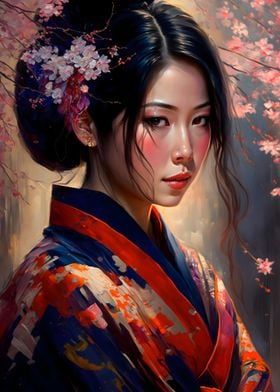2024 Gypsy's Prose : How to Write Haiku by Gypsy Blue Rose
|

HAIKU is a Japanese short unrhymed poem that uses imagistic language to express the essence of a deeply felt moment in time. It resonates on a deeper level, enlightening the reader and making an insightful connection HAIKU was created in Japan in the thirteenth century. It was the opening phrase of a long poetic form called RENGA. The much shorter haiku broke away from renga in the sixteenth century and was mastered a century later by Matsuo Basho. He was a Zen monk and poet of the Edo period ( between 1603 and 1868 ) in Japan. He is recognized as the greatest haiku master. His ancient “Pond and Frog” haiku is considered one of the best haiku in Japanese history. Keep in mind that many Japanese haiku translated to English lose meaning in translation. Notice the same ‘frog in the pond poem’ haiku in Japanese and English have different syllables count. JAPANESE VERSION Furu ike ya ( 5 syllables ) kawazu tobikomu ( 7 syllables ) mizu no oto ( 5 syllables ) ENGLISH TRANSLATION
old pond… ( 2 syllables ) a frog jumps in ( 4 syllables ) water's sound ( 3 syllables CONFUSING A 5/7/5 POEM FOR A HAIKU I get a lot of questions about haiku in fanstory, one of them is “What is the difference between a 5/7/5 poem and a haiku?”. The simple answer is that a 5/7/5 poem's rules are simple, use 17 syllables in a 5/7/5 format. I add that if the lines are grammatically connected the poem flows better, otherwise it sounds like a list or a telegram. 5/7/5 Poem example:
My dear Aunt Minnie loves to bake banana pies for her family
Haiku example: from the porch contemplating the harvest moon — wisdom quest The 5/7/5 POEM example is not a haiku, because it’s simply a paragraph divided in three lines. It doesn’t have the two essential parts of haiku: a KIGO and a SATORI. KIGO is word or phrase associated with a particular season (spring, summer, autumn, or winter). SATORI is a phrase (usually last line) that provides understanding. It refers to a deep experience of one's essence of true nature. It’s commonly translated as enlightenment. The HAIKU example is a haiku because it follows the haiku rules. — The first two lines describe a moment in nature using imagistic words. Imagistic words are expressions of ideas and emotions through clear precise images. Almost all Japanese poetry use imagism. It’s a very visual art form, and the reason I like it so much. — In the haiku example above, the harvest moon is the season word (kigo) for autumn. — It’s written in 17 syllables OR LESS because English and Japanese languages are different. See the example below. — Haiku are succinct poems so you never use more words than you need but make sense. For example: cold winter day (winter is always cold); summer hot weather ( most summer days are hot); cold snow (snow is always cold). — At the end of the second line, the haiku has a dash to pause before reading the third line (satori). It makes the reader ponder about life as a wisdom quest. — It never rhymes, usually avoid poetic devices, such as alliteration, personification, metaphor. — Avoid punctuation or capital letters except for proper names and the dash before the satori. — Write in present tense verbs. — The poet is the observer and usually doesn’t use the first person pronoun ( I, me, we, us, mine, ours, myself, and ourselves ). HISTORY OF ENGLISH HAIKUHAIKU reached the West in 1868. A group of English and American poets who called themselves IMAGISTS took a special interest in haiku. Imagism was a movement in early-20th-century Anglo-American poetry that favored precision of imagery and clear, sharp language. Zen influenced haiku for its personal tranquility, and its encouragement of education and art. As a result, the haiku translations of scholars H.G. Henderson (1934-1958) and R.H. Blyth (1949) began to promote Haiku in the United States. During the 1970s and 1980s, English-language haiku became more entrenched in North American culture with over a dozen periodicals: Haiku Poets of Northern California, Haiku North America, and Haiku Society of America, to name a few. I hope you find this lesson helpful. I love Haiku. Feel free to ask me any questions. Thank you
|
| ©
Copyright 2025.
Gypsy Blue Rose
All rights reserved. Gypsy Blue Rose has granted FanStory.com, its affiliates and its syndicates non-exclusive rights to display this work. |



